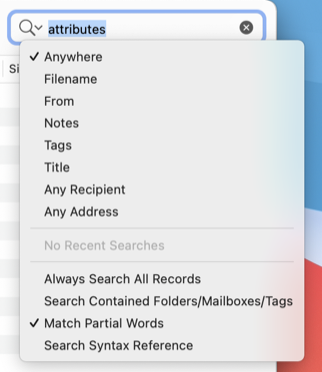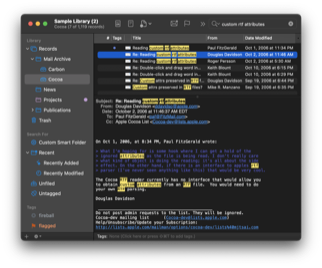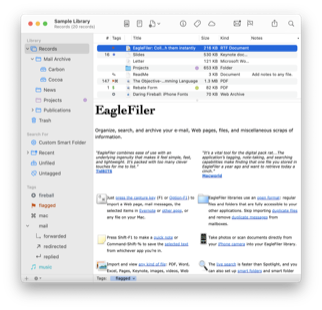EagleFiler 1.9.8
June 22nd, 2022 (EagleFiler)Version 1.9.8 of EagleFiler is now available.
EagleFiler makes organizing and managing your information easy. It lets you archive and search mail, Web pages, PDF files, word processing documents, images, and more. Use it to collect information from a variety of sources. Browse different types of files using a familiar three-pane interface. Organize them into folders and annotate them with tags and notes, or leave everything in one folder and pin-point the information you need using the live search. Since EagleFiler stores its library in Finder format, you can use it in concert with the other tools in your Mac ecosystem.
EagleFiler is a digital filing cabinet, a research assistant, snippet collector, and document organizer. You can use it to write a journal, track all the files for a project or job, manage your bookmarks, save your favorite Web articles, store financial statements and receipts, run a paperless office, plan a trip, collect your course notes, archive your e-mail correspondence, search mailing list archives, research a purchase, remember recipes to cook or books to read, store scientific papers, sort photos, gather legal case notes, or assemble a scrapbook. It’s the most flexible tool on your Mac.
This is a free update that includes the following enhancements:
 Added preliminary support for the forthcoming macOS 13 Ventura.
Added preliminary support for the forthcoming macOS 13 Ventura.- Added support for displaying files from the Bike outliner.
- You can now drag and drop attached files from a record’s note or from an RTFD record to other apps, e.g. to Finder to extract them or to Mail to attach them to a new e-mail message.
- When a file is attached to a record (i.e. included in its note), you can now hover the cursor over the attachment’s icon to see a tooltip showing its filename.
 When you import messages exported from Gmail via Google Takeout, the labels are now searchable in EagleFiler.
When you import messages exported from Gmail via Google Takeout, the labels are now searchable in EagleFiler.- Improved EagleFiler’s search indexing, so that you can now find links in Web archives, find e-mail messages by Message-ID or Reply-To, and find records by their EagleFiler GUID.
- If a note is missing, when EagleFiler reports this in the Errors window, you can now use the Trash or Update Checksum button to suppress further error reports if you can’t or don’t want to restore the note file from backup.
 The format for metadata backups has been revised so that it is faster and more efficient in memory and on disk, particularly when there are many records in the same folder or there are notes with large attached files. The XML files are no longer updated with spurious changes, which is more friendly for libraries that are backed up, synced, or under version control. The new format also works around a macOS limitation where very large notes could not be backed up. EagleFiler will still read backups in the old format when importing or rebuilding, and you can click here to enable an esoteric preference if you want it to still write the old format for interoperability with previous versions of EagleFiler.
The format for metadata backups has been revised so that it is faster and more efficient in memory and on disk, particularly when there are many records in the same folder or there are notes with large attached files. The XML files are no longer updated with spurious changes, which is more friendly for libraries that are backed up, synced, or under version control. The new format also works around a macOS limitation where very large notes could not be backed up. EagleFiler will still read backups in the old format when importing or rebuilding, and you can click here to enable an esoteric preference if you want it to still write the old format for interoperability with previous versions of EagleFiler. A record’s title and its filename are no longer automatically linked when you set them to the same value, only when you set the title to be blank. This allows EagleFiler to better preserve your intent, i.e. that the title should stay at the current value even if the filename changes.
A record’s title and its filename are no longer automatically linked when you set them to the same value, only when you set the title to be blank. This allows EagleFiler to better preserve your intent, i.e. that the title should stay at the current value even if the filename changes.- The filename counter is now preserved when rebuilding a library. This means that markers like -1 and -2 will no longer double up (-1-2) if there are further filename conflicts, and they’ll go away entirely if the record is moved to a location where there is no filename conflict.
- The insertion point in the record viewer is easier to see in Dark Mode.
- Improved the display of certain Web archive files.
- Improved the speed of indexing e-mails with certain attachment types.
- Updated the Import From Instapaper via NetNewsWire script to accommodate a change in NetNewsWire.
 Updated the following sections of the manual:
Updated the following sections of the manual:
- Updated the Read Me.
- You can now omit the library parameter in an x-eaglefiler link, which means that EagleFiler will look for the record in the current library.
- Record GUIDs in x-eaglefiler links are now purely alphanumeric for easier searching and double-clicking to select.
- Adjusted the toolbar layout of the Errors window to make it clearer what options are available for each error.
- Improved the error reporting when a record can’t be moved.
- Updated to version 1.5.3 of the SkimNotes framework.
- EagleFiler is better at handling and working around file system errors when creating a smart folder or editing a file.
- Worked around a macOS bug that could cause a crash when importing multiple Evernote files at once.
- Fixed a bug where a record’s preference for linking its title and filename was sometimes not preserved when rebuilding the library.
 Fixed a bug where the record viewer might not update its display when changing to a new record if you had just renamed the previous one.
Fixed a bug where the record viewer might not update its display when changing to a new record if you had just renamed the previous one.- Fixed a bug that could cause an error backing up the metadata shortly after editing a record.
- Fixed a bug where the source list’s colored circle label indicator wasn’t positioned correctly when using the small sidebar icon size on macOS 12.3.1.
- Fixed a bug where a smart folder could get messed up if you tried to rename it to the empty string.
- Fixed a bug where EagleFiler showed the copy cursor when moving a tag to a different parent.
- Fixed a bug where phrase searches containing a colon might not find anything.
- Fixed a bug where accessing a record’s guid via AppleScript failed if one had not been previously assigned.
- Fixed a bug where some background operations could report an internal error after a record was deleted.
EagleFiler 1.9.8 works with macOS 10.12 through macOS 13. Older EagleFiler versions are available for older versions of macOS. In-depth information about EagleFiler is available in the manual.
If you enjoy using EagleFiler, please take a moment to review it on the Mac App Store, Product Hunt, or MacUpdate or to mention it on Twitter, Facebook, or your own site. We’d really appreciate it.
EagleFiler 1.9.8 has been submitted to the Mac App Store and is awaiting approval from Apple.
EagleFiler 1.9.8 is now available from the Mac App Store.